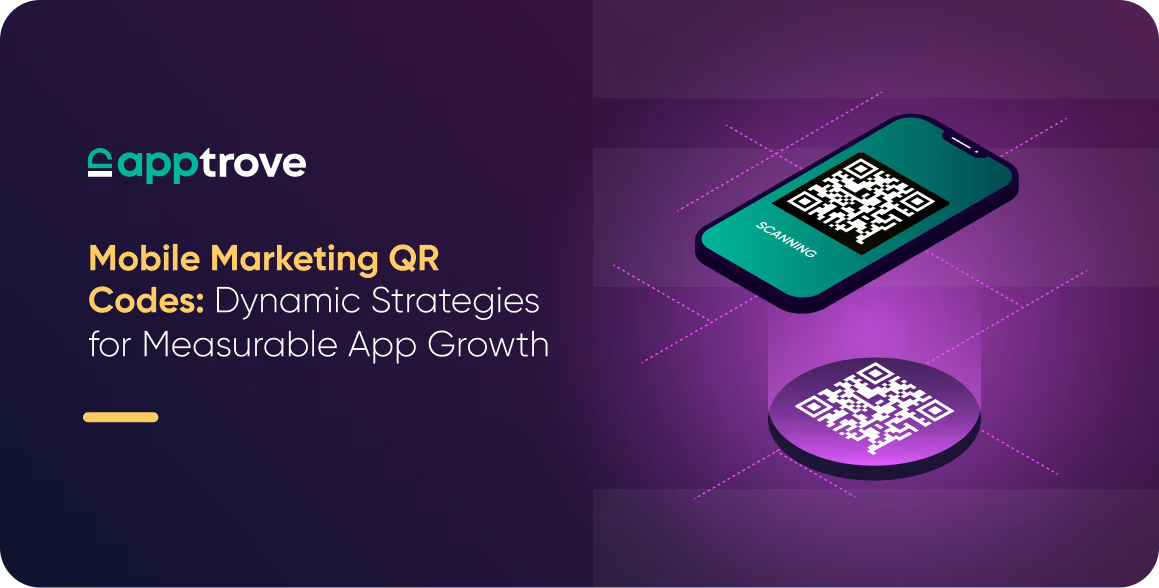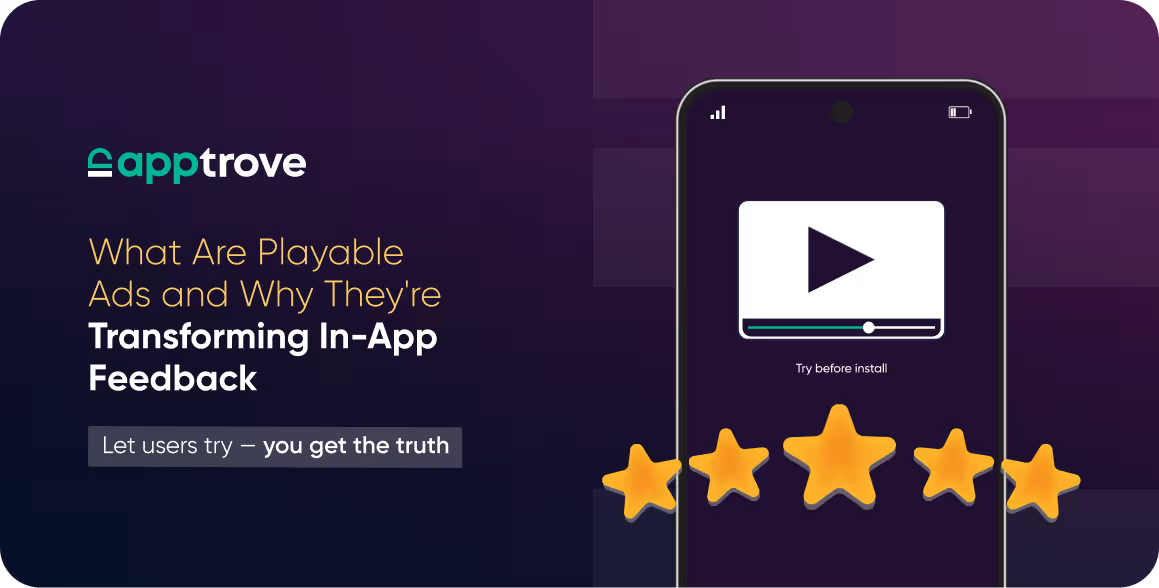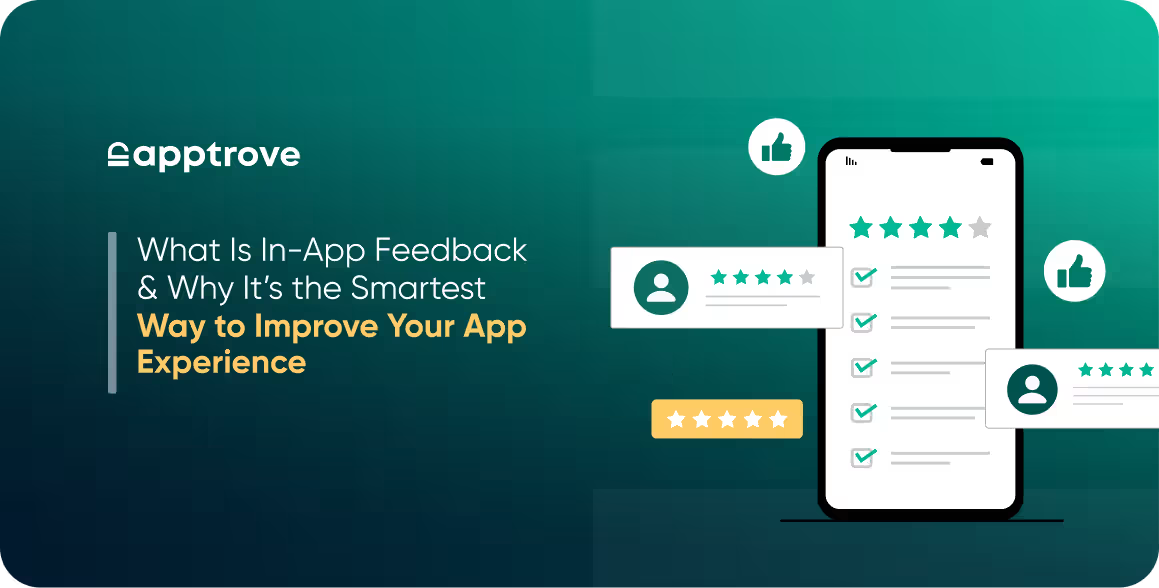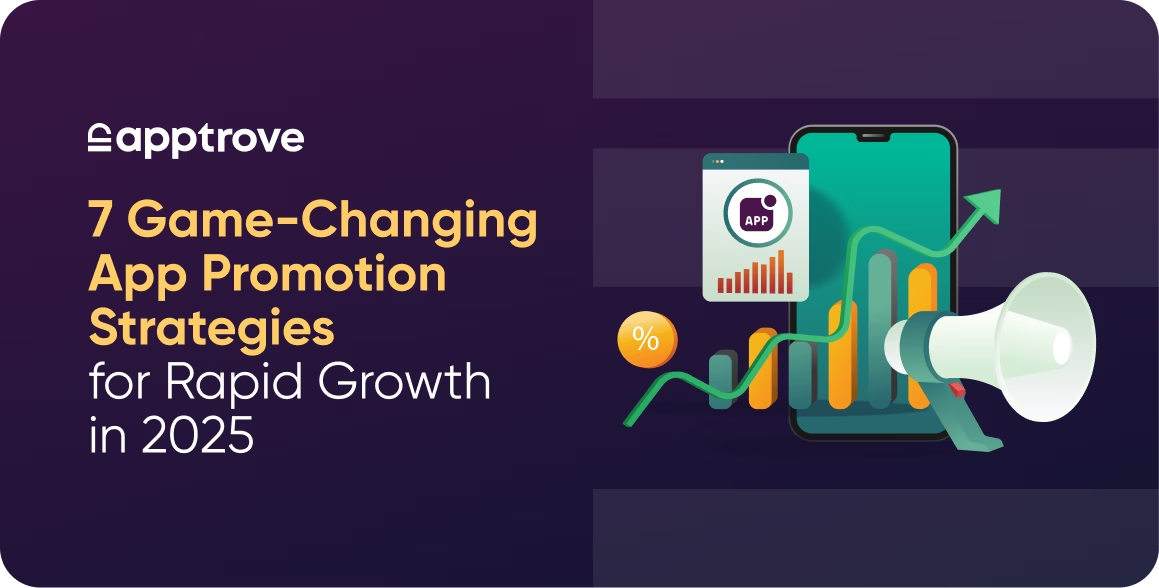Smartphones have become the most powerful connection between brands and consumers. Push notifications, deep linking, and in-app ads often receive the most attention, however, the most undervalued yet effective form of mobile marketing is the QR code.
QR codes first appeared in the consumer market for marketing purposes around 2011. And in the last 10 years, mobile marketing QR codes have grown from being simple black-and-white squares, to dynamic, data-driven gateways of engagement. They aren’t just for scanning a menu at a restaurant anymore! Today they drive app downloads, document offline campaigns, and unlock interactive experiences.
In this blog, we’ll look at why mobile marketing QR codes should be a part of every app marketers toolbox, how to implement them in an effective manner, and how to optimise them for search engines, answer engines and generative AI. By the end, we’ll explore why mobile marketing QR codes are critical for acquisition, engagement, and retention, how to set them up for success, and how Apptrove helps you measure what really matters.
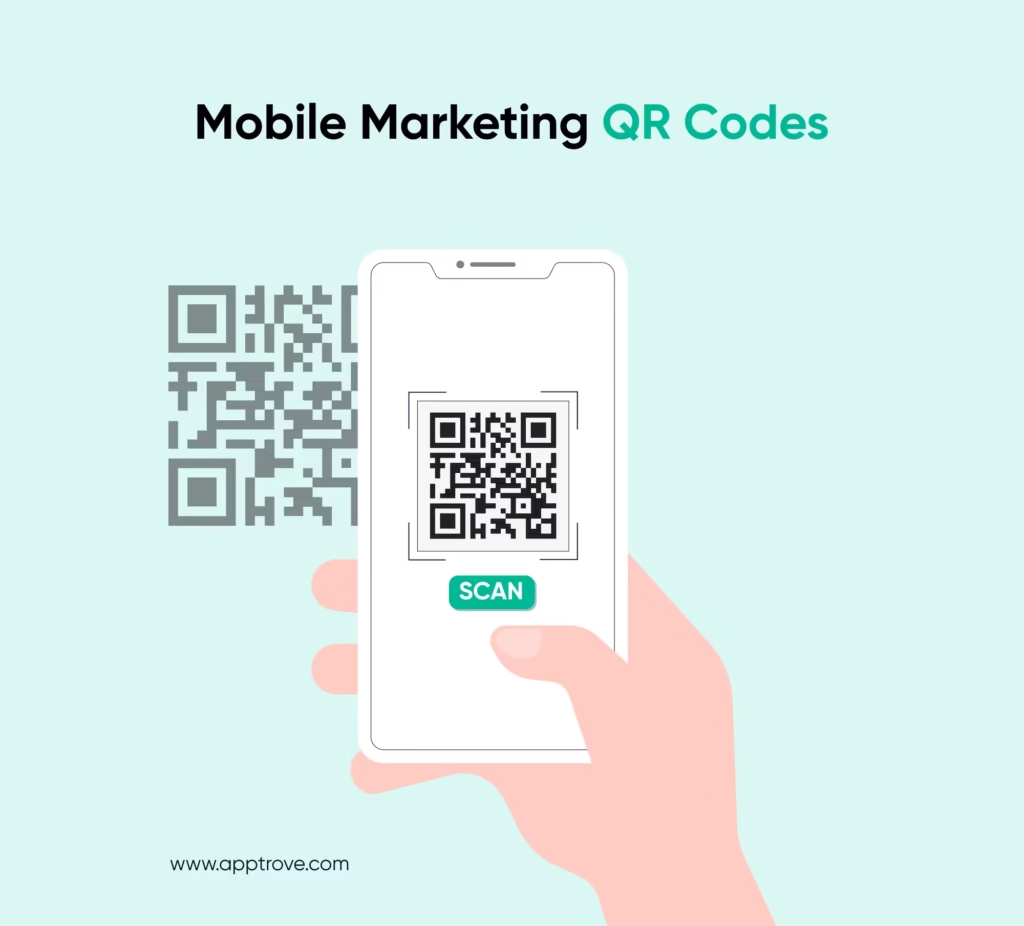
Why Mobile Marketing QR Codes Are Driving Results
The rise of mobile marketing QR codes is no accident. They deliver three things app marketers crave:
- Seamless user experience: No typing URLs, no searching the App Store. A scan takes users directly where you want them.
- Performance edge: QR campaigns often achieve click-through rates (CTR) of up to 37%, significantly outperforming traditional banner ads.
- Cross-channel flexibility: From offline billboards to Instagram posts, QR codes unify your messaging across touchpoints.
In a world where attention spans are short and acquisition costs are rising, mobile marketing QR codes lower friction between interest and conversion.
Static vs. Dynamic QR Codes: What Marketers Need to Know
Not all QR codes are equal. For mobile marketing campaigns, the choice between static and dynamic can make or break your strategy.
| Type | How It Works | Pros | Cons | Best Use Cases |
|---|---|---|---|---|
| Static QR Codes | Encodes a fixed URL that can’t be changed | Simple, cheap, no ongoing costs | No tracking, no updates, limited analytics | One-time promotions, disposable campaigns |
| Dynamic QR Codes | Redirects to a URL you can update anytime | Editable, trackable, supports UTMs, flexible | Requires a platform for generation and management | Scalable campaigns, attribution, long-term use |
For serious marketers, dynamic mobile marketing QR codes are essential. They allow you to:
- Change destinations post-launch without reprinting.
- Run A/B tests by rotating landing pages.
- Add UTM tags for granular performance tracking.
- Attribute scans back to installs, sessions, and revenue through platforms like Apptrove.
Why Mobile-First QR Code Landing Pages Matter
The strength of your QR code is not the code itself, but the place where the code will answer best practices of landing pages with mobile QR codes. Think of how much time you waste scanning a code and finding yourself on a page that is too slow to open, is not openable on your own phone, or is too messy and confusing. You are going to bounce no doubt at all.
That is why the use of mobile-friendly QR Code landing pages is not an option at this stage. Google is becoming conscious of user experience; it is no longer a question of whether user experience is important or not, but rather how much. Since Google has a mobile-first indexing system, in which mobile experience outweighs desktop page loading speed, page loading speed is not a consideration. Provided that you spend too much time on UX, this will have several consequences on performance that can hardly be compared with the initial site:
- User trust and interest: When the page loads in seconds, there is a pronounced call to action, and it seems to be native-to-mobile, the user would give much more thought to the next step, either downloading your app, buying, or registering.
- Search visibility: Search engines capture positive indicators, such as low bounce and high dwell time. Content is typically sampled by generative engines, which typically generate signals based on highly engaging content.
This, in effect, implies that with every QR campaign that you launch, creating a mobile-designed landing page is the most important aspect for app marketers.
The Power of Dynamic QR Codes for Mobile Campaigns
The Static QR Codes are similar to print advertisements, which cannot be modified once posted in the street. Nevertheless, mobile campaigns in the form of dynamic QR codes should not be considered the same.
Dynamic QR codes allow you to:
- Change landing page destination: You can change the landing page destination even after printing and distributing your codes.
- Include UTM parameters: You can monitor the codes like links and capture your campaign effectiveness better.
- A/B test destination: Separate a group of users to a single experience (arguably a video on a first destination landing page) and separate a group of users to another landing page experience.
Dynamic QR codes are the best friend of a marketer with these advantages. Suppose you are promoting the holidays. When your holiday offer expires, you would have to republish all that involves the use of the QR code to enable users to access your new offer if you use a static QR code. You would only need to change the destination of the link in the case of dynamic QR codes to another link of another offer – no redrawing or reprinting would be needed!
This is the priceless flexibility of app marketers. It enables them to make campaigns responsive to real-time outcomes and develop a feeling of newness in the campaigns, scalability, and flexibility to the evolving user requirements.
Tracking Success: QR Code Analytics with UTM
It is like sailing without a compass to market blindly. That is where QR code analytics to your mobile campaigns comes in.
With UTM tracking added to the URLs of your QR codes, you can analyze:
- Scan volume: How often did you scan your QR codes?
- User location: Where you found yourself in your campaign.
- Device: What mobile devices were used in scanning?
- Time of engagement: The time within which the users were likely to scan.
Measurement is something we usually dismiss; hence, they are not vanity metrics. They inform your strategy. As an illustration, when you notice that there is a spike in QR scans during the weekend, then you can change your push notification or ad spend. You can also confidently customize your hyperlocal targeting in case some geographies have a higher scan rate.
By using services such as Bitly or Scanova, you will also be able to understand these insights much more precisely, and with an MMP such as Apptrove, you can tie your QR activity directly to your user acquisition, retention, and revenue numbers.
Enhancing Engagement: Interactive Mobile QR Experiences
An ordinary QR code is alright; however, an interactive mobile QR experience brings a scan down to a moment and a memorable brand experience.
For example:
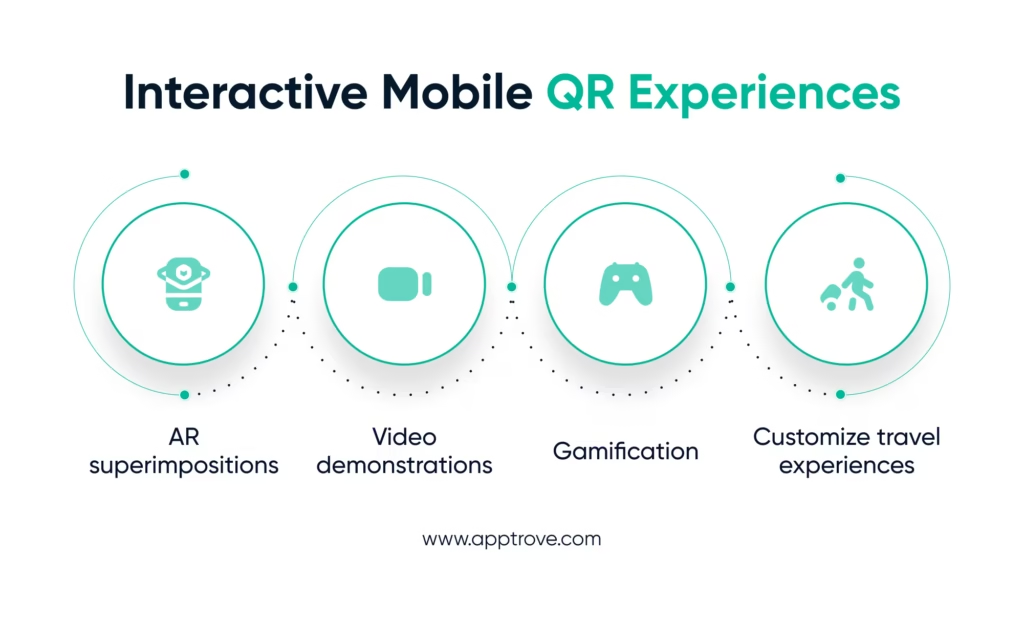
- AR superimpositions: Visualize a 3D product image.
- Video demonstrations: Scan to go to a fast, user-friendly explainer of a product.
- Gamification: Use points, money off, or challenges after scanning.
- Customize travel experiences: Add rich connections right into the screens of the apps, rather than the homepage.
Turning the QR usage into an experience rather than transactional campaigns. QR codes do not lead to nowhere. QR codes are able to form immersive points of entry to the user, generate increased mobile user engagement, and increase retention rates.
Interactive cues also possess a longer time, more involvement, and propose more pulling by longer movement signals. The more engaging cues and the longer movement you develop can provide a feedback mechanism with the SEO programs and training data of generative AI. Enhance content searchability and Google AI-generated content suggestions.
FAQs
1. What’s the difference between static and dynamic mobile marketing QR codes?
Static QR Codes store unchangeable information and cannot be updated once created. Dynamic QR Codes, however, allow you to change or update the destination URL or campaign information at any time thereby allowing a more autonomous marketing strategy over time.
2. How do mobile marketing QR codes help in app marketing campaigns?
They create a seamless link between offline and online touchpoints, leading users straight to actions such as app installs, promotions, or in-app offers. Creating minimal friction in user journeys makes it easier to engage with users and fosters a level of campaign engagement.
3. How can Apptrove improve the performance of my mobile marketing QR codes?
Apptrove advances QR performance with deep linking, attribution, and analytics, ensuring users arrive at the right destination in the app. It also gives you insights into user behavior making it easier to adjust campaigns for greater ROI.
4. Why are mobile-first landing pages critical for QR success?
Most QR scans happen on smartphones, so mobile-first landing pages ensure a fast, responsive, and user-friendly experience. This reduces bounce rates and increases conversions from your QR-driven campaigns.
5. How do mobile marketing QR codes impact SEO?
When used with optimized landing pages, your QR codes can produce repeat visitors and lengthen dwell time on-page, which contributes to engagement, and if you want to keep things positive, engagement is a good signal for search relevance.
